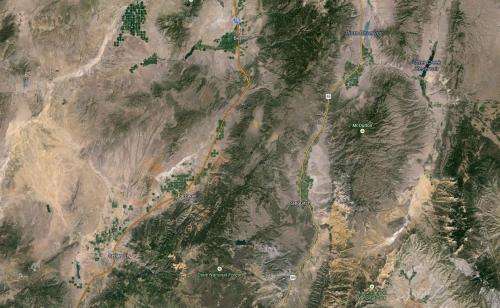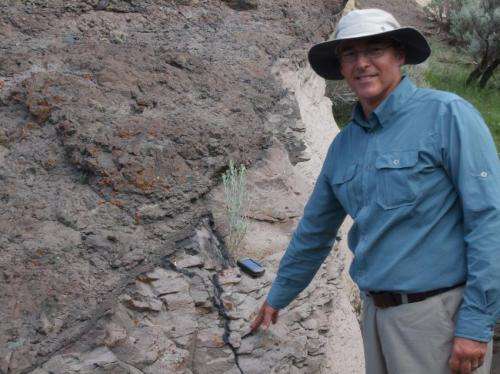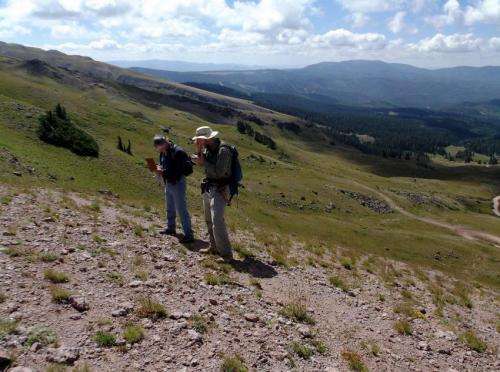November 19, 2014 report
New study shows ancient volcanic field in Utah actually one massive landslide

(Phys.org) —A trio of geologists in the U.S. has found that an ancient volcanic field in what is now southern Utah was actually once the site of one of the largest known landslides to ever occur on the planet. In their paper published in the journal Geology, David Hacker, Robert Biek and Peter Rowley describe the compelling evidence they found and conclude that a massive landslide occurred in the area approximately 22 million years ago.
For many years geologists have believed that landslide evidence in the area suggested that many landslides had occurred over a period of time, giving rise to the unusual terrain. In this new effort, the researchers suggest the evidence points very strongly to a single massive landslide that covered an area 90 kilometers long and 40 kilometers wide, which they now call the Markagunt gravity slide.
In studying the area, the researchers found it's actually a multi-layered field—at the bottom there is weathered volcanic ash, some of which had decayed into slippery clay. The middle layer is volcanic material from nearby volcanoes. On top is the material that slid, up to 200 meters thick in some places. All of it sat on a gentle slope, which allowed for a massive buildup. Eventually though a tipping point was reached, and all it took to set it off apparently, was a seismic event of some sort that shook the field enough to cause fissures, separating matter at higher elevations from those that were lower. The team believes the slide was fast—they found evidence of friction turning some of the bottom layer to glass—and clearly devastating to everything in its path—they believe material slid as far as 30 kilometers, leaving huge blocks clearly out of place and pulverized rock near its edges.
Today the area is covered with forest, offering non-geologists few clues as to what occurred all those years ago. The team plans to continue surveying the area, suspecting that once all the data is in, the slide will surpass the Heart Mountain slide as the largest known slide to have occurred. It also shows that such massive events, unlike anything seen in modern times, are possible in the future.
-

David Hacker, Ph.D., points to pseudotachylyte layers and veins within the Markagunt gravity slide. Credit: Photo courtesy of David Hacker -

Co-authors Peter Rowley, left, and Robert Biek examine rock structures near the breakaway zone of the Markagunt gravity slide. The slide extends to the horizon behind them. Credit: Photo courtesy of David Hacker
More information: Catastrophic emplacement of the gigantic Markagunt gravity slide, southwest Utah (USA): Implications for hazards associated with sector collapse of volcanic fields, First published online September 15, 2014, DOI: 10.1130/G35896.1 , geology.gsapubs.org/content/ea … 15/G35896.1.abstract
Abstract
The newly recognized Markagunt gravity slide (MGS) represents gravitationally induced, catastrophic collapse, ca. 21–22 Ma, of the southwest sector of the Oligocene to Miocene Marysvale volcanic field in southwest Utah (USA). The ∼90-km-long slide mass consists of ∼1700–2000 km3 of andesitic volcanic mudflow breccias and subordinate lava flows, sandstones, and intertongued regional ash-flow tuffs. The MGS extends over an area of >3400 km2 and advanced >30 km to the south over the Miocene land surface. The low-angle basal slip surface is in Eocene–Oligocene Brian Head Formation, a weak, clay-rich, tuffaceous sedimentary unit at the base of the volcanic section. The presence of a basal zone of cataclastic and sheared breccia with associated clastic dikes, and pseudotachylyte along secondary shear planes, provides strong evidence of catastrophic emplacement. The uniformity of directional indicators, stratigraphy, and overall geometry of the MGS suggests that it represents a single emplacement event coeval with late-stage magmatic doming of the volcanic field. The MGS thus represents one of the largest subaerial volcanic landslides on Earth, and along with the comparable Heart Mountain gravity slide in northwest Wyoming, constitutes a class of catastrophic collapse hazard not widely recognized within modern volcanic fields.
Journal information: Geology
© 2014 Phys.org




















